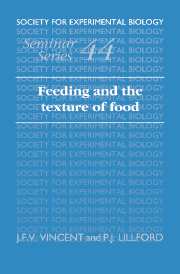Book contents
- Frontmatter
- Contents
- List of contributors
- Introduction
- Mechanical and fracture properties of cellular and fibrous materials
- Texture of plants and fruits
- Measuring meat texture and understanding its structural basis
- Food processing by mastication in cyprinid fish
- Quantitative aspects of the relationship between dentitions and diets
- The control of movements and forces during chewing
- The basic mechanics of mastication: man's adaptive success
- Integrating texture and physiology – techniques
- Brittle textures in processed foods
- The control and generation of texture in soft manufactured foods
- Texture and acceptability of human foods
- Index
Introduction
Published online by Cambridge University Press: 14 January 2010
- Frontmatter
- Contents
- List of contributors
- Introduction
- Mechanical and fracture properties of cellular and fibrous materials
- Texture of plants and fruits
- Measuring meat texture and understanding its structural basis
- Food processing by mastication in cyprinid fish
- Quantitative aspects of the relationship between dentitions and diets
- The control of movements and forces during chewing
- The basic mechanics of mastication: man's adaptive success
- Integrating texture and physiology – techniques
- Brittle textures in processed foods
- The control and generation of texture in soft manufactured foods
- Texture and acceptability of human foods
- Index
Summary
To the biologist, especially the zoologist, the mechanical properties of food are treated rather vaguely: from an early age one is taught that carnivorous mammals have special teeth for coping with meat, but the properties of the meat which is being coped with are left variously as vague, assumed or obvious. The real answer is not only that the mechanical properties of meat are very subtle and difficult to measure, but that they are variably dependent upon a range of factors, few of which are properly understood (Purslow, this volume). Problems can be taken to a finer degree of resolution: within the range of animals which eat other animals it is possible to differentiate between the dentition of those which are specialised to eat hard-bodied insects (e.g. beetles) and those which can eat soft-bodied insects (e.g. caterpillars). Recent work (J.F.V. Vincent and S. Strait, unpublished results) suggests that the differences in dentition in these two types of animal (which may be closely related bats, or primitive primates) are based on the fracture mechanics of the food items – beetles are brittle and can be crushed; caterpillars are more ductile and have to be cut.
Food scientists are aware of some of these subtle differences in the mechanical properties of food and their implications. Much current research in industry and academia is directed at understanding the mechanics of food and the ways in which the mechanical properties of a wider variety of starting materials can be brought into the relatively narrow area of mechanical competence of the mouth. This can be illustrated by considering man's early efforts in food science.
- Type
- Chapter
- Information
- Feeding and the Texture of Food , pp. xi - xivPublisher: Cambridge University PressPrint publication year: 1991



